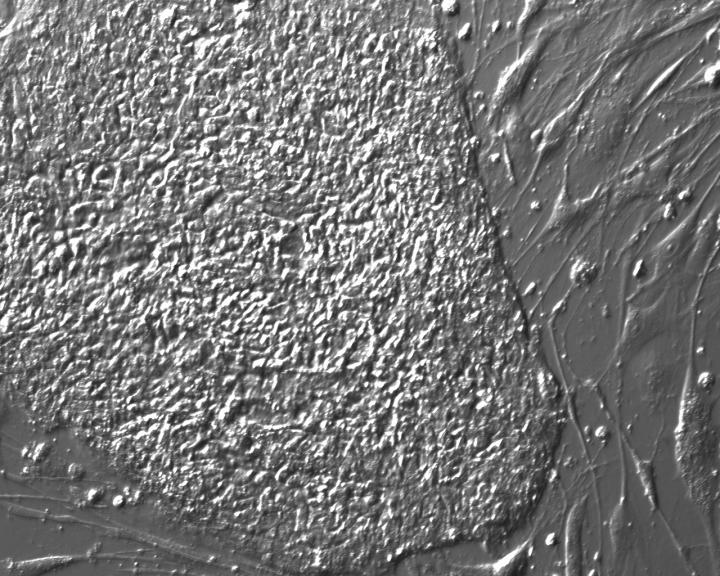
Credit: AlphaMed Press
Durham, NC – Human pluripotent stem cells (hPSCs) hold promise in the field of regenerative medicine for how they give rise to every other cell type in the body and for their ability to propagate indefinitely. Their potential, however, is hampered by the body’s tendency to reject any “allogeneic” cells or tissue, which means that the cells come from a donor other than the patient. This rejection is due to the body’s immune system labeling the cells as “foreign invaders” and setting in motion a series of strategies intended to ward off what it deems an attack — leaving researchers scrambling for a way around this protective measure.
A paper released today in STEM CELLS details a method that might provide the answer. The authors report on how they genetically edited out a key set of proteins found on the surface of the hPSCs that are the targets of immune rejection, basically rendering them invisible to the body’s immune system.
The multi-institutional research team was led by Xiaoqing Zhang, M.D., Ph.D., and Lin Ma, Ph.D., from the Tongji University School of Medicine. “What we have done is taken advantage of the non-classical human leukocyte antigen (HLA) molecules, which encode the main targets of allograft rejection, to construct hypoimmunogenic hPSCs,” Dr. Zhang said. “Our strategy not only ameliorates the body’s main immune-rejection weapons — T cells (especially CD8+ Ts), natural killer (NK) cells and antigen-presenting cells — but also attenuates cell contact-triggered cell killing and immunogenicity of the allograft environment.”
The work grew out of their knowledge that the HLA-G family is one of the most prominently expressed HLA class I molecules in the placenta, with the job of protecting fetal tissue from the mother’s immune system. “It’s a remarkable example of immune accommodation in mammals,” Dr. Zhang explained. “So we engineered hPSCs using CRISPR/Cas9 gene-editing technology for beta-2 microglobulin (?2m) knock out, or for biallelic knock-in of HLA-G1 within the endogenous ?2m loci. Elimination of the surface expression of the HLA proteins protected the hPSCs from cytotoxicity mediated by the CD8+ T and NK cells. The lack of surface expression also resulted in missing-self recognition and aberrant NK cell activation.”
Dr. Jan Nolta, Editor-in-Chief of STEM CELLS, said, “the development of this method to shelter pluripotent stem cell derivatives from the immune system is a “game-changer” in the field. If this innovative technique can next be carried forward to clinical trials it could mean that recipients of the cells would need no immune suppression. We are very happy to publish this novel and potentially paradigm-shifting research.”
Dr. Ma added, “To the best of our knowledge, this is the first study to report that engineered β2m- HLA-G5 proteins are soluble, secretable and can efficiently protect donor cells from immune responses. This not only provides a novel strategy to generate hypoimmunogenic human cells for allografting, but also sheds light on the role of HLA-G in immune tolerance during pregnancy and organ transplantation.”
The next step, the two say, will be to address any safety concerns with the engineered cells, including whether they have a higher risk of growing tumors given their capability to escape immune surveillance. “Introducing a controllable suicide gene might provide an efficient way to remove the risk,” Dr. Ma said. “If all goes well, the engineered hPSCs could serve as an unlimited cell source for generating universally compatible ‘off-the-shelf’ cell grafts in the future.”
###
The full article, “Generation of hypoimmunogenic HPSCs via expression of membrane-bound and secreted β2m-hla-g fusion proteins,” can be accessed at https:/
About the Journal: STEM CELLS, a peer reviewed journal published monthly, provides a forum for prompt publication of original investigative papers and concise reviews. The journal covers all aspects of stem cells: embryonic stem cells/induced pluripotent stem cells; tissue-specific stem cells; cancer stem cells; the stem cell niche; stem cell epigenetics, genomics and proteomics; and translational and clinical research. STEM CELLS is co-published by AlphaMed Press and Wiley.
About AlphaMed Press: Established in 1983, AlphaMed Press with offices in Durham, NC, San Francisco, CA, and Belfast, Northern Ireland, publishes three internationally renowned peer-reviewed journals with globally recognized editorial boards dedicated to advancing knowledge and education in their focused disciplines. STEM CELLS® (http://www.
About Wiley: Wiley, a global company, helps people and organizations develop the skills and knowledge they need to succeed. Our online scientific, technical, medical and scholarly journals, combined with our digital learning, assessment and certification solutions, help universities, learned societies, businesses, governments and individuals increase the academic and professional impact of their work. For more than 200 years, we have delivered consistent performance to our stakeholders. The company’s website can be accessed at http://www.
Media Contact
Chelsea Kekahuna
[email protected]
Related Journal Article
http://dx.




